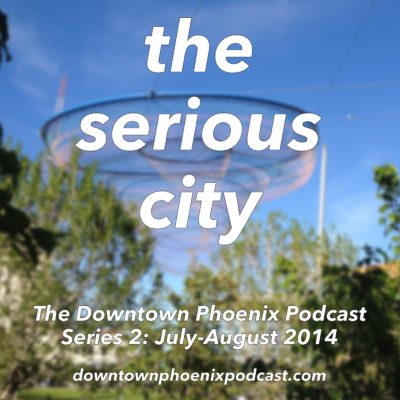 As part of this blog’s The Friday Five series, The Friday Urban Dispatch is a unique boots-on-the-ground report on the urban condition in Phoenix.
As part of this blog’s The Friday Five series, The Friday Urban Dispatch is a unique boots-on-the-ground report on the urban condition in Phoenix.
Roosevelt Streets Improvements. This week marked the completion and public dedication of the Roosevelt Street streetscape improvements, the anchor of which is shade structures designed by the artist Meejin Yoon. There have also been some controversial planter pots installed on the south side of Roosevelt between 1 and 3 Streets. I like them. I think they add a level of whimsy and artistic quality to a street that is supposedly about those things.
BIDding for Roosevelt, part II. As part of this month’s Hance Park Conservancy meeting (of which I am a member of their Board of Directors), a presentation was given by Nancy Hormann, the consultant helping to organize the proposed Roosevelt Row Business Improvement District. While on the surface, this is a good idea, the devil’s in the details. Of great concern is the non-inclusion of major cultural anchors in that part of the world, such as Burton Barr Central Library and Hance Park. A business improvement district, it would seem, would be more robust and more viable if it drew from a bigger pool of support.
Entertainment districts and civics lessons. The City of Phoenix is set to create the first of its three allotted “entertainment districts” in downtown Phoenix. As I explained to the Downtown Phoenix Partnership on their Facebook page (because there is no wrong time for a civics lesson), this entertainment district is something that is a function of Arizona Revised Statues (Title 4, Section 207). It has nothing to do with what we conceive of entertainment. Nor is meant the Legends Entertainment District, which is neither legendary nor entertaining. All it has to do with is that in this entertainment district, the State Liquor Board may entertain issuing a liquor license that is within 300 feet of a school or church, subject to the customary and normal approval mechanisms like everywhere else.
Moving Phoenix. In August, Phoenix voters will vote for Mayor and those in the odd-numbered Council Districts will vote for their councilperson. This blog recommends returning each incumbent to their seats. Five ballot questions are also for consideration and this blog recommends a YES vote on all of them, especially on Proposition 104, the adoption of Transit 2050. The package involves improvements to Phoenix’s public transportation network as well as financing much-needed repairs to our streets. If Phoenix is to have any chance to compete in the world economy, public transportation is a key component. Voters should vote YES on Proposition 104.
Cities attract talent. If Phoenix is to be a world city, which I think is a necessary aspiration, then it means we must not be afraid of new ideas from outside our own boundaries. Come to think of it, it’s what ALL cities must do. So it has been extremely frustrating that many in downtown Phoenix lament the opening of Meejin Yoon’s “Shadow Play” art installation mainly because Ms. Yoon is not a local artist. If that line of thinking is valid, should the Phoenix Public Library only shelve books by local authors? Should the Phoenix Art Museum only show works by Arizona artists? Or should the Phoenix Suns and Arizona Diamondbacks only field players from the area? Of course not because that is not good for all. There is a definite place for local involvement and the advancing of local interests. It is not, though, in our exposure to the arts and the humanities. We must not feel threatened by the broadening of our horizons.
 Downtown Phoenix In Review 2014: IV. Opportunities
Downtown Phoenix In Review 2014: IV. Opportunities One of the common criticisms of THE SERIOUS CITY is that people think it tries to invalidate existing ways of thinking about cities, place, and context. As I see it, that couldn’t be farther from the truth. This is a different way of thinking, true, but it builds upon all constructive ways of thinking about cities. It puts the focus of its thought on the policy side of the spectrum as more important than design.
One of the common criticisms of THE SERIOUS CITY is that people think it tries to invalidate existing ways of thinking about cities, place, and context. As I see it, that couldn’t be farther from the truth. This is a different way of thinking, true, but it builds upon all constructive ways of thinking about cities. It puts the focus of its thought on the policy side of the spectrum as more important than design. This week has been a perfect convergence of several events, conversations, and discoveries from the urban academy. (I love it when convergences like these happen!)
This week has been a perfect convergence of several events, conversations, and discoveries from the urban academy. (I love it when convergences like these happen!)